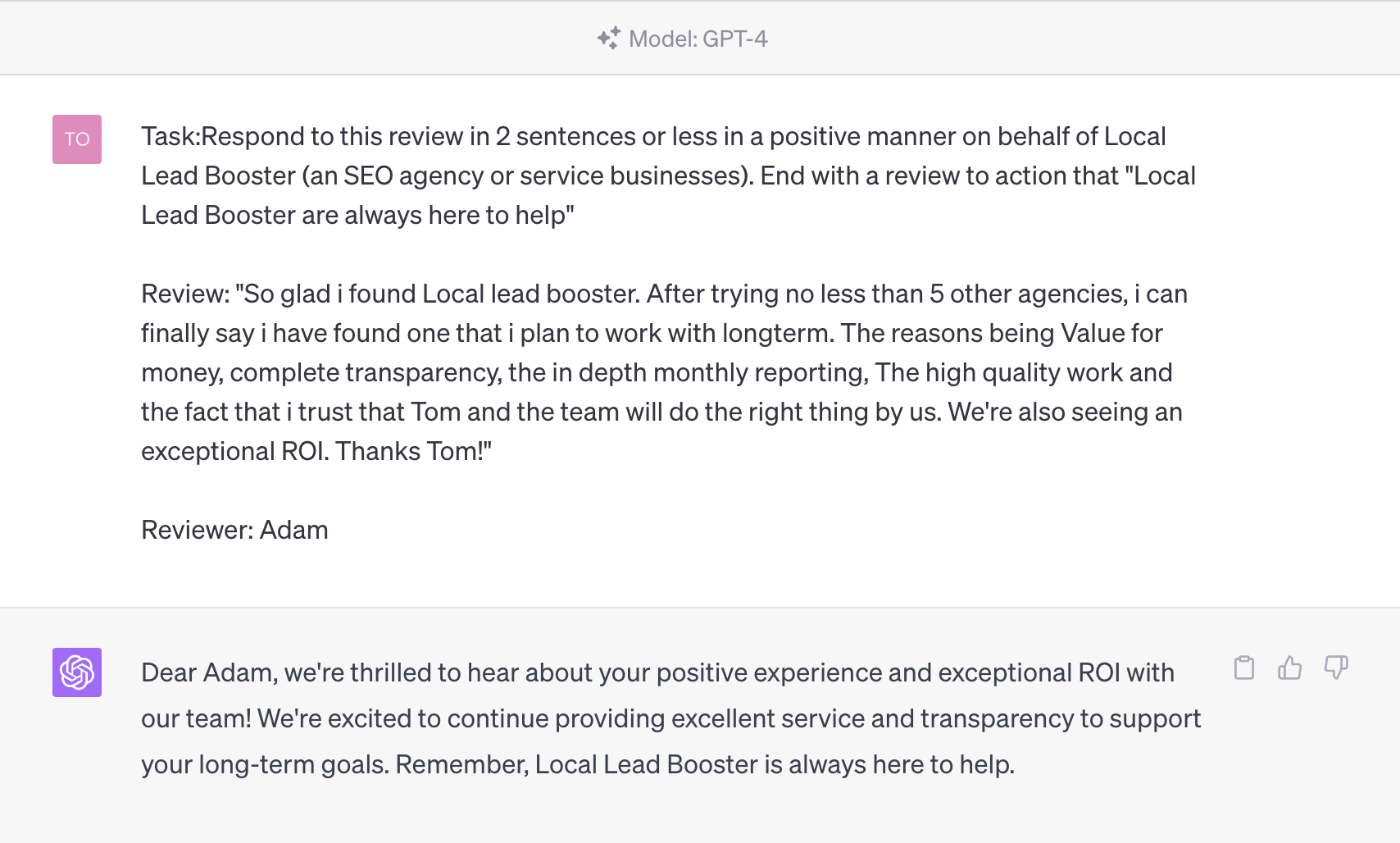Guide
How to Get More Google Reviews

by Tom Richards - Lead SEO & Director
In today’s digital landscape, customer reviews have become a cornerstone of success for businesses. They hold tremendous power in shaping a company’s reputation, fostering trust among potential customers, and ultimately driving customer acquisition.

Now more than ever, as local search and online directories play a pivotal role in connecting businesses with their target audience, the significance of customer reviews cannot be overstated.
Not only do reviews provide valuable insights into the quality of products or services offered, but they also hold the key to ranking higher in local search results and appearing prominently on maps.
In this guide, we will delve into the importance of customer reviews, their impact on reputation and local SEO, and uncover effective strategies for obtaining and managing reviews to propel your business towards success.
Why Reviews Are Important
Customer reviews play a vital role in the success of businesses for several compelling reasons. Understanding the importance of reviews can help you harness their power and leverage them to your advantage. Here are some key reasons why customer reviews are essential:
- Social Proof and Credibility: Customer reviews serve as social proof, showcasing the experiences and opinions of real customers. When potential customers see positive reviews from others who have already used your products or services, it boosts their confidence and credibility in your business.
- Influence on Consumer Decision-Making: Reviews have a significant impact on consumer decision-making and purchasing behaviour. Many consumers rely on reviews to gather information, assess the quality of a product or service, and determine if it meets their needs. Positive reviews can sway potential customers towards choosing your business over competitors.
- Improved Search Visibility: Reviews contribute to improved search visibility, especially in local search results. Search engines like Google consider customer reviews as a ranking factor, and businesses with a higher number of positive reviews often appear higher in search results. This increased visibility can attract more potential customers to your business.
Where to Get Reviews
When it comes to obtaining customer reviews, it’s important to target key platforms where reviews carry weight. Here are the top platforms you should focus on:
- Google My Business: Google reviews are essential for local SEO and search rankings. Optimise your Google My Business profile to encourage positive reviews and improve your visibility on Google.
- Facebook: Facebook reviews help build trust and engagement. Encourage customers to leave reviews on your Facebook page to enhance your reputation and attract more potential customers.
- Yelp: Yelp reviews are particularly important for service-based businesses. Create a strong presence on Yelp by generating positive reviews and managing your profile effectively.
- Other Directories: Explore relevant directories like TripAdvisor, Yellow Pages, and industry-specific platforms. Utilise these platforms to expand your reach and attract customers in your industry.
By focusing on these key platforms, you can leverage customer reviews to enhance your business’s reputation, credibility, and visibility.

Getting Customers to Take Action
Actively soliciting reviews from customers is essential to consistently gather valuable feedback. In this section, we’ll explore effective strategies for motivating customers to leave reviews.
- Incentivising: Ethically incentivise customers by offering exclusive discounts, loyalty points, or freebies as a token of appreciation for their feedback.
- On the Spot: Capture immediate feedback by using methods like comment cards, tablets or kiosks, or making in-person requests for reviews.
- Email & Text: Use email and text message campaigns to encourage reviews. Craft personalised messages with direct links or QR codes for convenience.
Pro tip: Incentivise your team to get reviews
Boost your team's motivation to generate reviews by implementing a rewards program. Offer a special incentive, like a free lunch on the company, to the team member who generates the most reviews.
5 Ways to Collect Reviews
Five proven strategies that will help you gather valuable feedback and generate a consistent stream of positive reviews. From leveraging QR codes to implementing automated email campaigns, these methods are designed to make the review collection process seamless and rewarding.
QR Code on Your Phone
Simplify the process of collecting reviews by using QR codes. Generate a QR code that customers can scan with their mobile devices to access a review page directly. This method eliminates the need for customers to search for your business manually, making it convenient and easy for them to leave feedback. Implement QR codes on marketing materials and streamline the review collection process for enhanced customer engagement.
We use SQR.CO
Currently are using sqr.co for QR code generation, however, there are plenty of great free options on the market.
QR Review Cards
Enhance your review collection efforts by offering physical review cards with QR codes to your service-based business customers. These cards contain a QR code that customers can scan to access a review page specifically designed for your business. Place these cards at your reception desk, waiting area, or hand them out after providing services to encourage customers to leave reviews.
We recommend Vistaprint
Using Canva you can create a simple business card, add the QR code that links to your GBP/GMB, then order your review card through Vistaprint and have delivered to your door for under $20.
Manual Email or Text
To collect reviews manually via email or text, start by identifying satisfied customers who would be willing to provide feedback. Craft a personalised message expressing gratitude for their business and kindly request their feedback. Make it easy for them to leave a review by including direct links to your review platforms. Customise each message with the customer’s name and mention specific details about their experience to make it more personalised.
Recommended if have a very personalised service
Our client, a criminal lawyer, sometimes has clients who might not be satisfied with the outcome, even though it represents their best possible solution. They utilize a strategic approach to minimize the risk of negative reviews.
Automated Email or Text
Automated email or text systems streamline the review collection process by automating review request emails or text messages to customers. These tools save time and effort by scheduling and customising requests. Look for reputable tools that integrate with popular review platforms for a seamless experience. Automating the process increases efficiency and boosts the likelihood of receiving more customer reviews.
Recommended rep.co or Podium
Numerous softwares cater to this need, but we particularly recommend rep.co for those mindful of their budget and Podium, should its additional features prove beneficial.
Include Review Link in Email Signature
Boost your review collection efforts by including a review link or call-to-action in the email signature of all your outgoing business emails. This simple addition increases the chances of capturing reviews from recipients who engage with your email communication. Make it easy for customers to leave reviews by providing a direct link to your preferred review platform.
Recommended Hubspot free email signature generation
We're big fans of the HubSpot free signature generator; it's user-friendly and delivers an excellent end result.
Replying to Reviews
When replying to reviews, businesses have two options: manual or AI-powered responses.
Manual Process:
- Monitor reviews regularly.
- Read and analyse the reviews.
- Craft personalised responses.
- Use a professional and empathetic tone.
- Offer solutions or assistance.
- Sign off with your name or business name.
AI-Powered Process:
- Utilise AI-powered review management tools.
- Review and customise suggested responses.
- Maintain a personal touch.
- Follow the same guidelines as the manual process.

We are currently using ChatGPT for review responding
Previously Local Lead Booster were using Jasper's Review Responder template which is great, but ChatGPT does just as good a job for a lower cost.
Dealing with Negative Reviews
Dealing with negative reviews requires a professional and effective approach to address customer concerns and resolve issues. Here are some strategies to handle negative reviews:
- Stay calm and objective: Avoid reacting defensively. Take time to understand the customer’s perspective and emotions before responding.
- Respond promptly: Timely responses show that you value customer feedback and are committed to addressing their concerns.
- Apologise and empathise: Acknowledge the customer’s experience and express genuine empathy for their dissatisfaction.
- Offer a solution: Provide a practical and reasonable solution to address the customer’s specific complaint or issue.
- Take the conversation offline: Encourage the customer to contact you directly to discuss the matter further and find a resolution privately.
- Maintain professionalism: Use a polite and respectful tone throughout the response, even if the review is unfair or unjustified.
- Learn from feedback: Use negative reviews as an opportunity to identify areas for improvement and make necessary changes to enhance the customer experience.
By handling negative reviews professionally and effectively, businesses can demonstrate their commitment to customer satisfaction and showcase their willingness to resolve issues, ultimately preserving their online reputation.
Handling Fake Reviews
Dealing with fake reviews poses challenges for businesses and can significantly impact their reputation. Here are some tips for handling fake reviews:
- Spotting fake reviews: Look for suspicious patterns, such as multiple similar reviews from new or anonymous accounts, overly positive or negative language, or reviews that don’t provide specific details about the experience.
- Verify customer identity: Cross-check the reviewer’s information with your records to ensure they are legitimate customers.
- Gather evidence: Collect any evidence that supports your suspicion of a fake review, such as screenshots of unusual review patterns or interactions with the reviewer.
- Respond professionally: Craft a polite response addressing the concerns raised in the review without directly accusing it of being fake. Focus on providing helpful information to potential customers.
- Report to the platform: Most review platforms have policies against fake reviews. Report the suspicious review with the evidence you’ve gathered to the platform for investigation.
- Encourage genuine reviews: By actively encouraging satisfied customers to leave honest reviews, you can dilute the impact of fake ones.
- Monitor and manage your online reputation: Regularly monitor your online presence to identify and address any fake reviews promptly.
Find the Approach that Works for Your Business and Stick to It
Finding the right approach to review generation is crucial for every business. Here’s how to discover what works for you:
- Experiment with different methods: Try various review generation strategies, such as in-person requests, email campaigns, or review cards, to gauge their effectiveness. Analyse the results and identify the methods that yield the highest response rates.
- Understand your target audience: Consider the preferences and behaviours of your target audience. For example, if your customers are more tech-savvy, QR codes or online review platforms might be effective. If they prefer personal interactions, in-person requests might work better.
- Consistency is key: Once you find an effective review generation method, stick with it. Consistency builds trust and makes it easier for customers to leave reviews.
- Nurture ongoing efforts: Review generation should be an ongoing process, not a one-time activity. Continuously encourage customers to leave reviews, and regularly monitor and respond to them.
- Track and measure results: Use analytics and customer feedback to evaluate the impact of your review generation efforts. Adjust your strategies based on the feedback and data you receive.
Remember, finding the approach that works for your business may require some trial and error. Stay open to experimentation, adapt to customer preferences, and maintain consistency in your review management efforts. By doing so, you can maximise the benefits of customer reviews and enhance your business’s online reputation.


